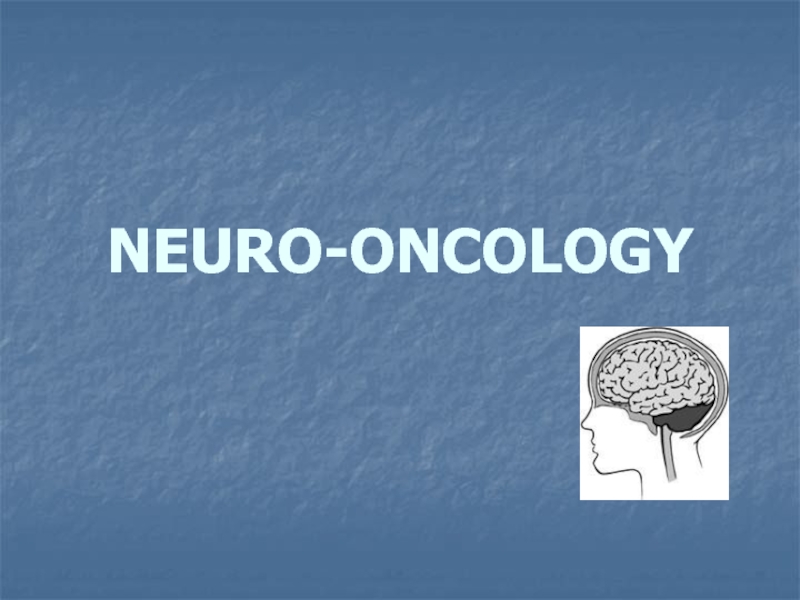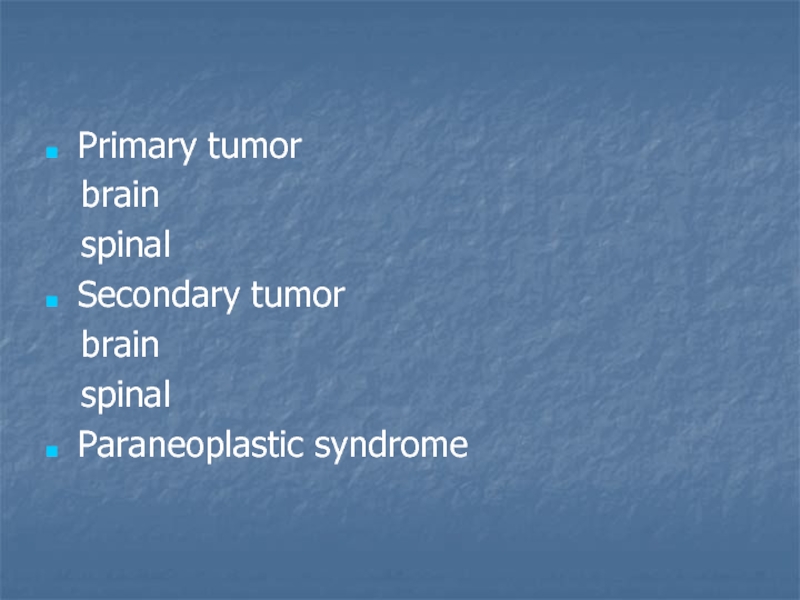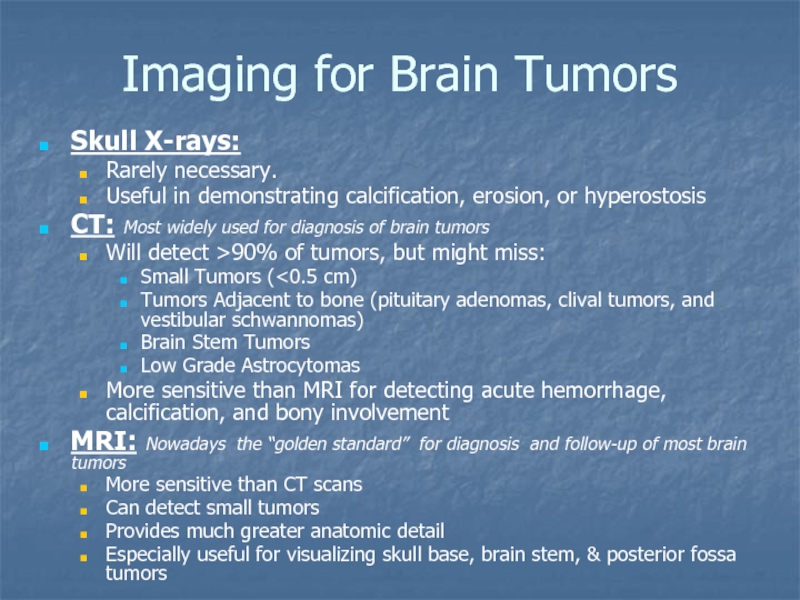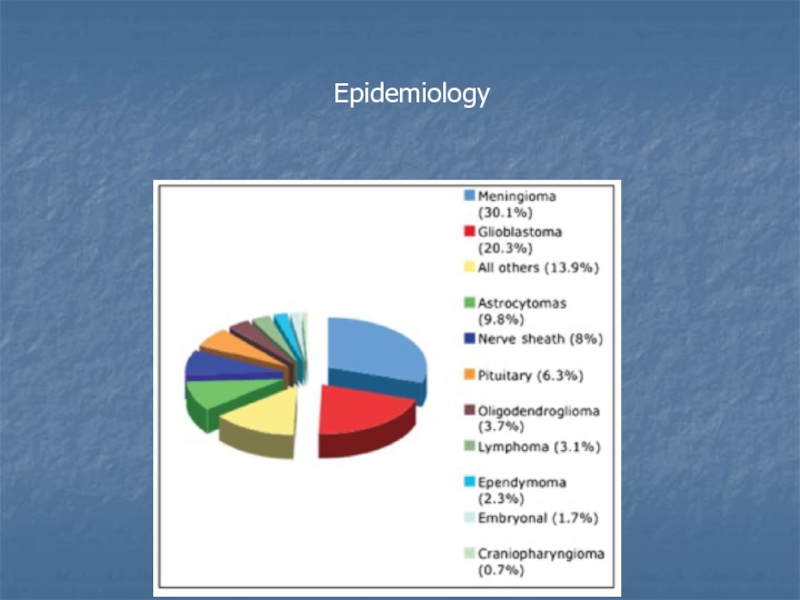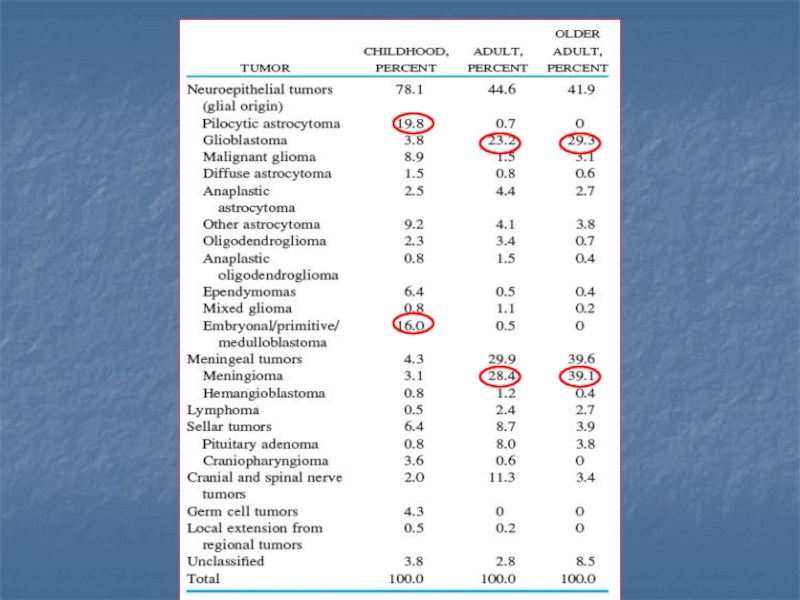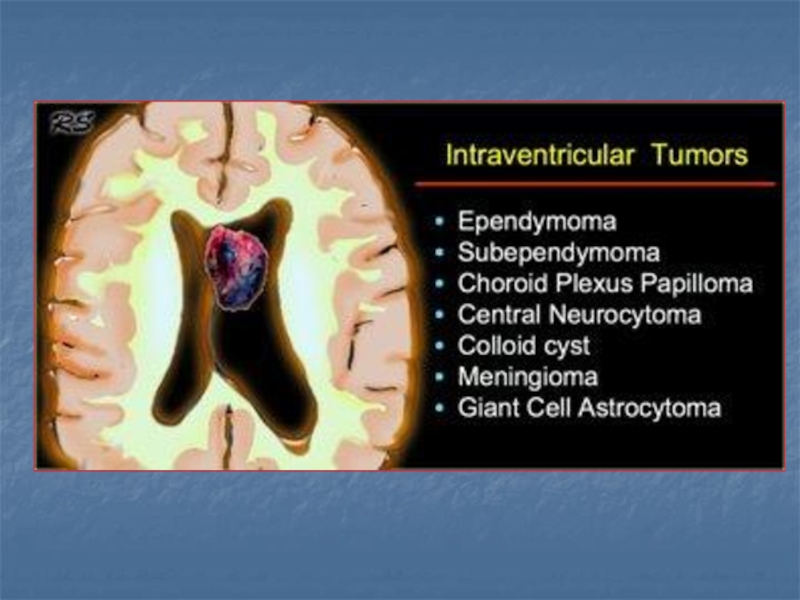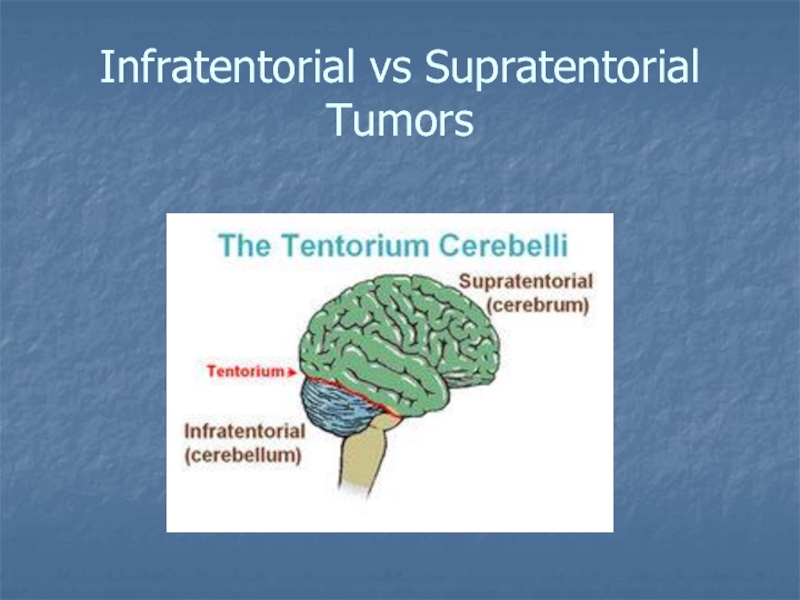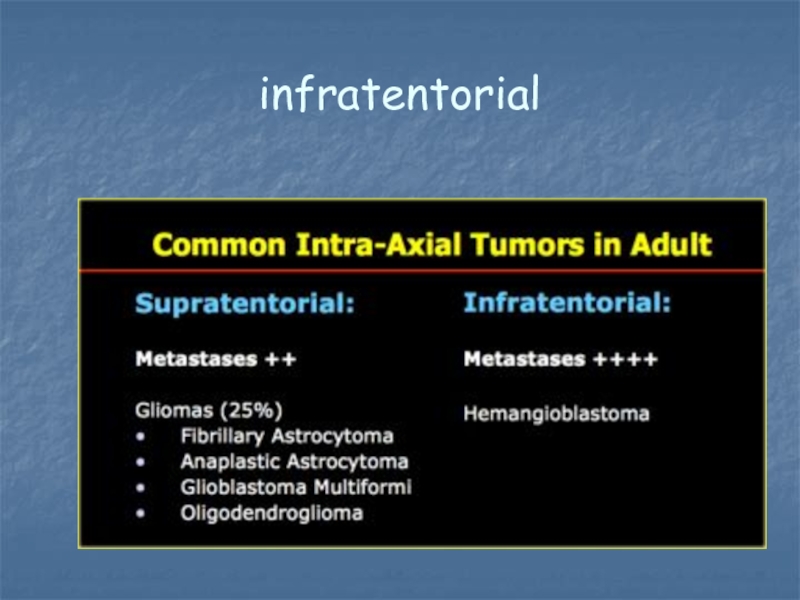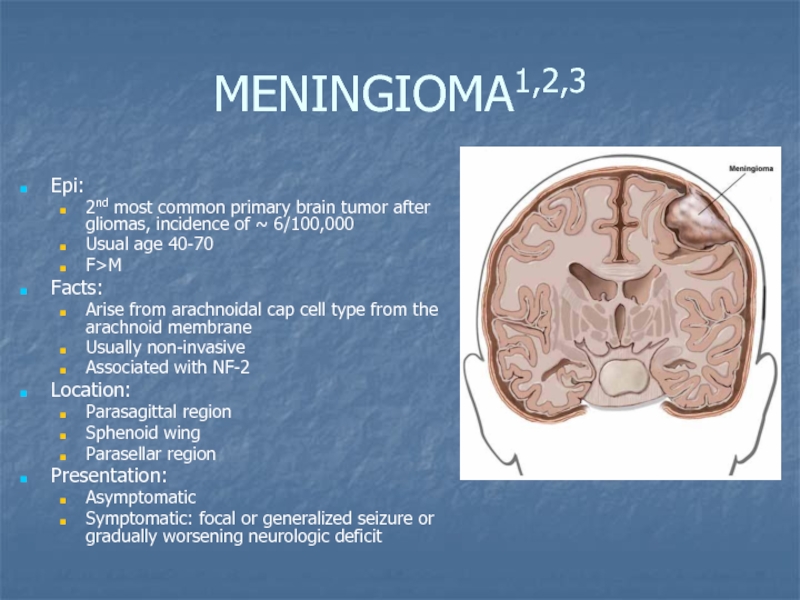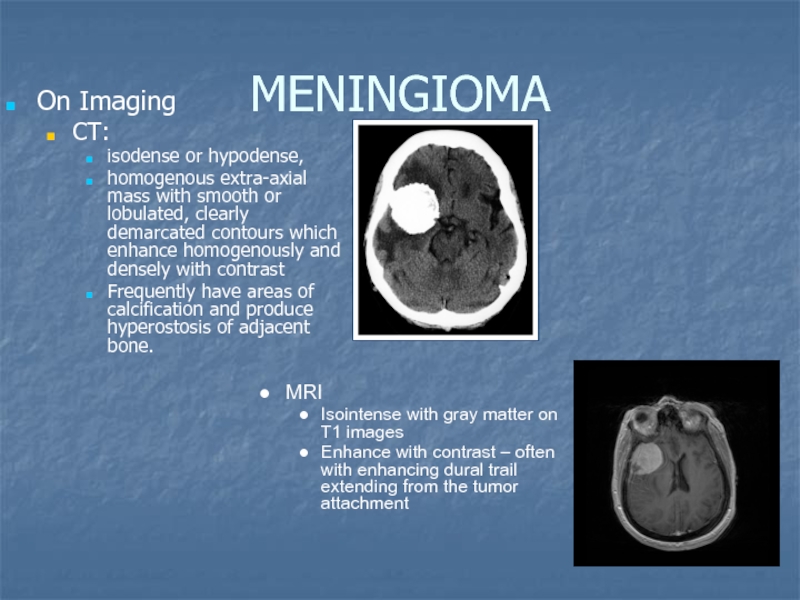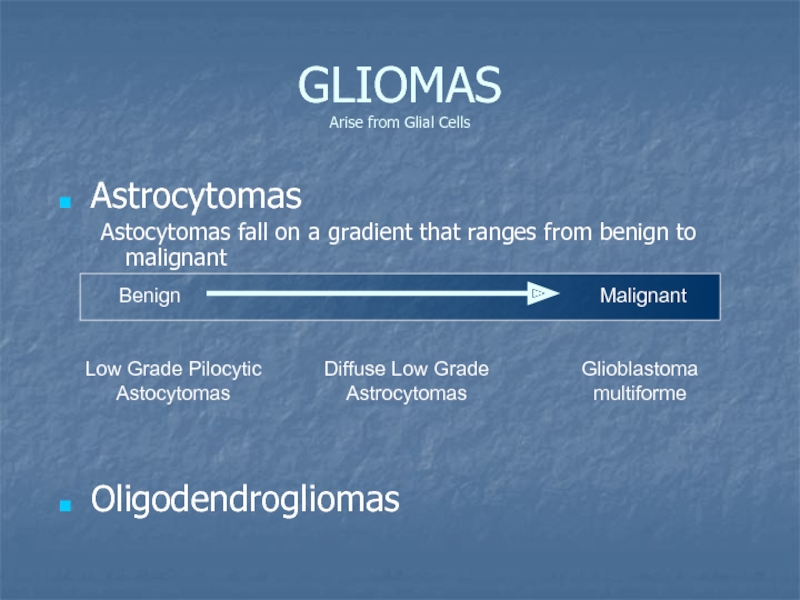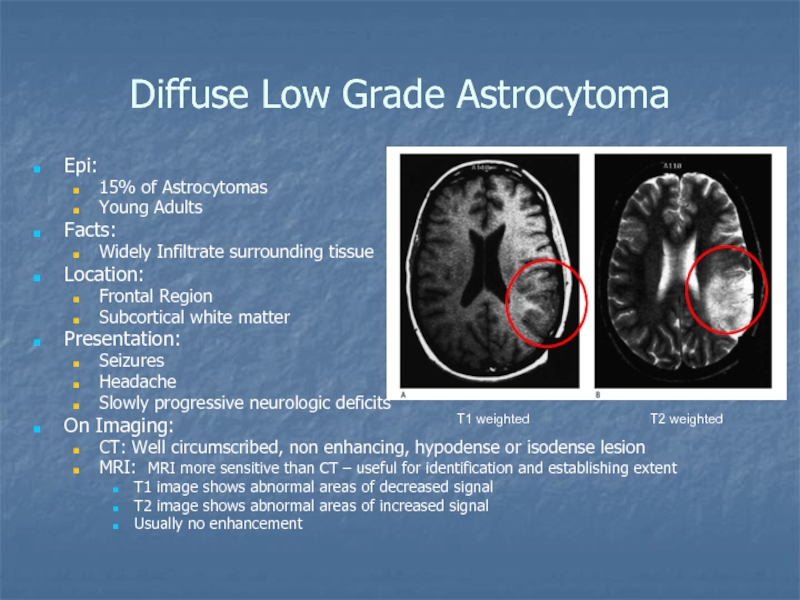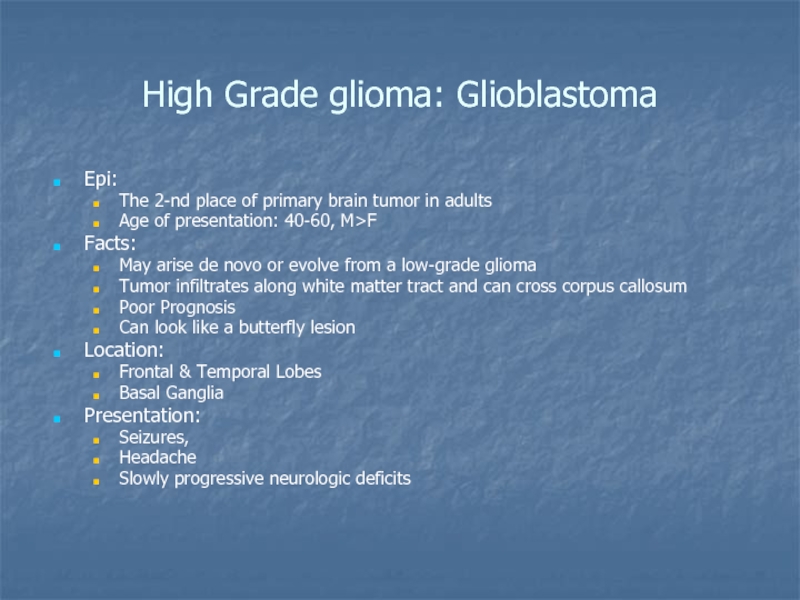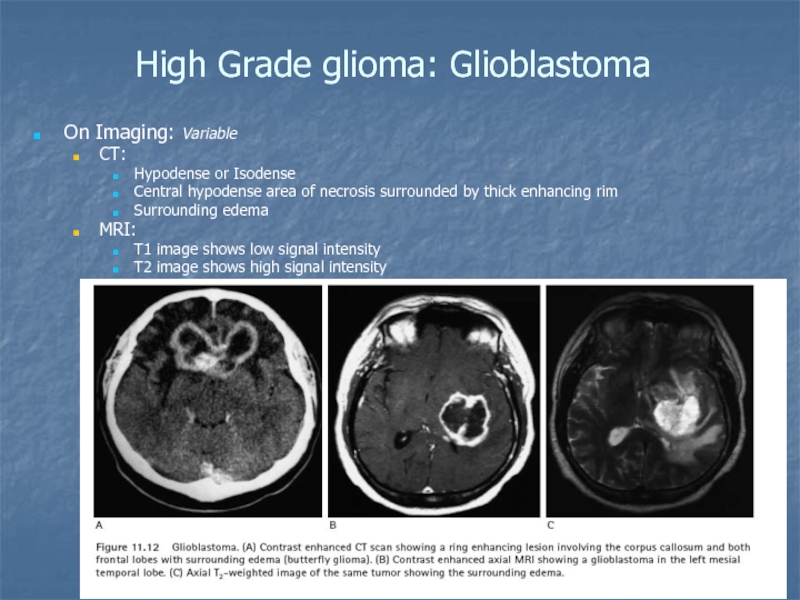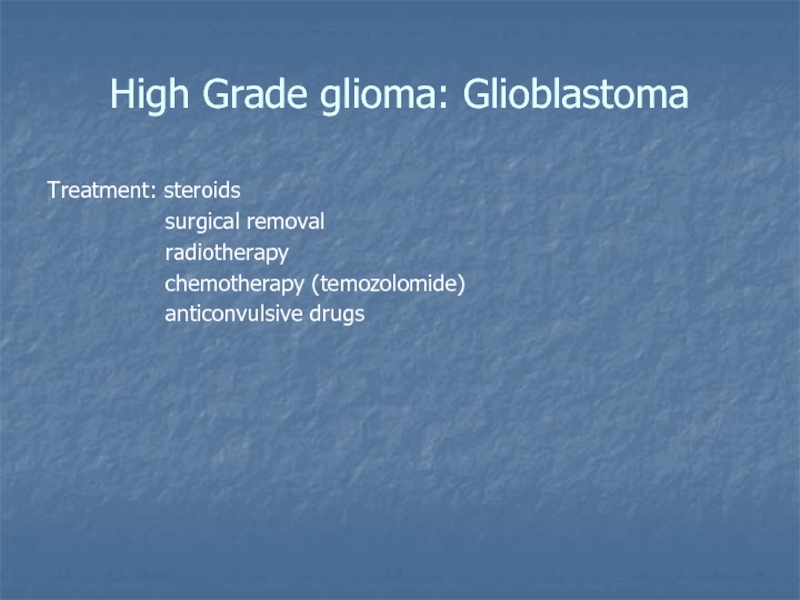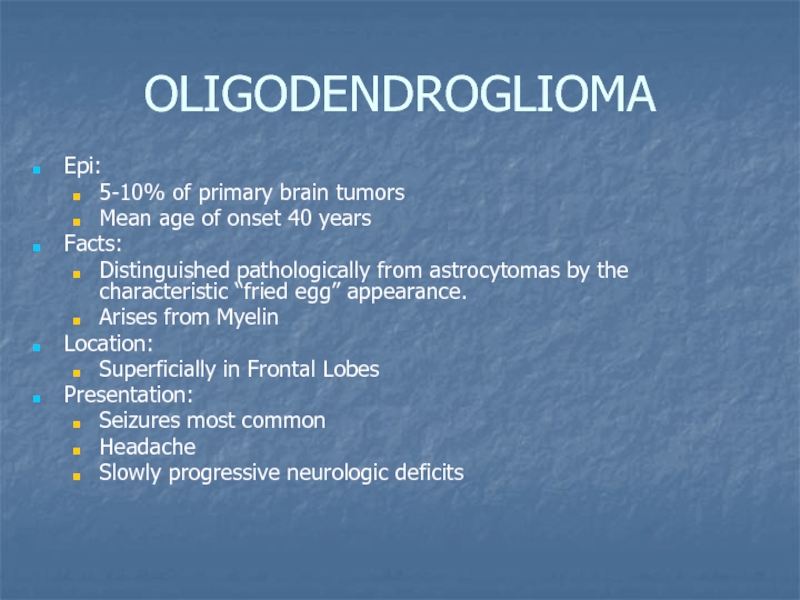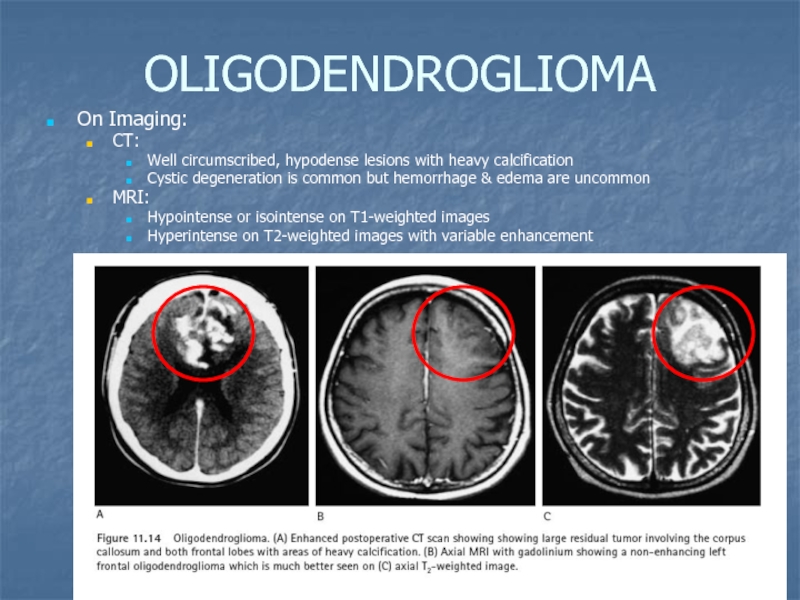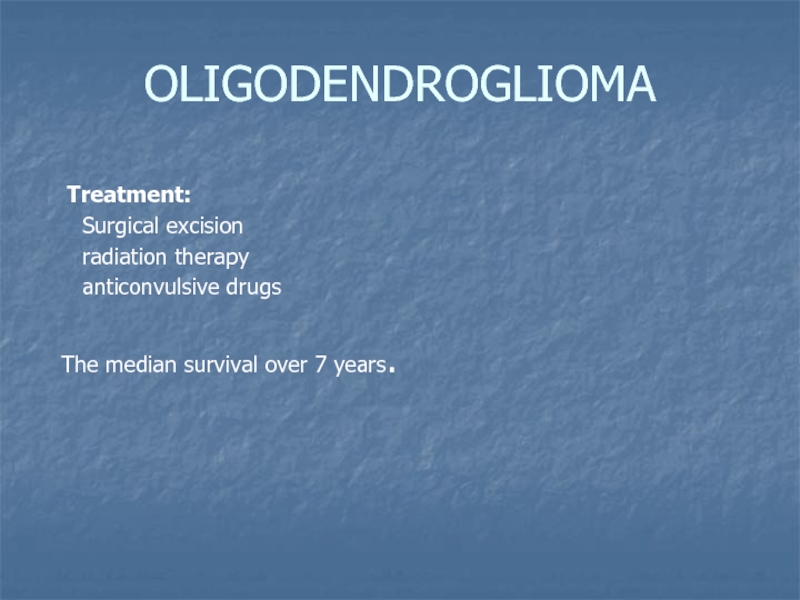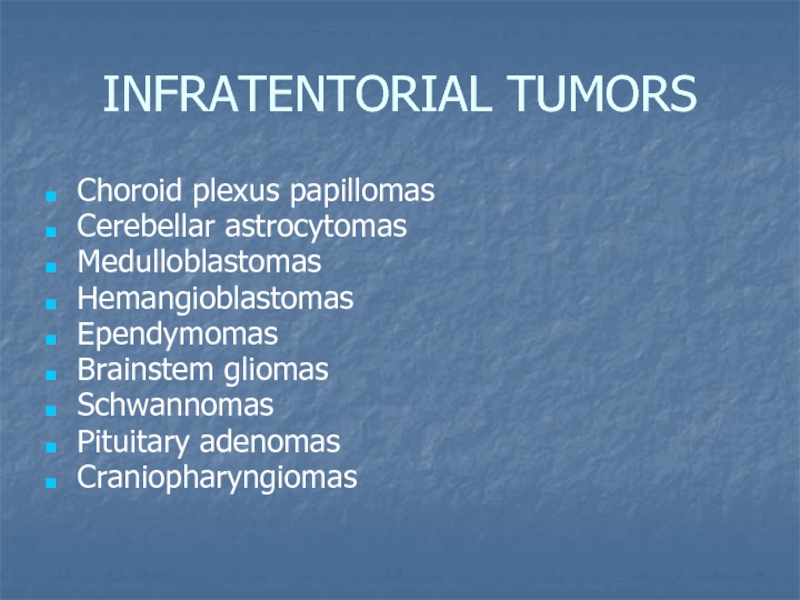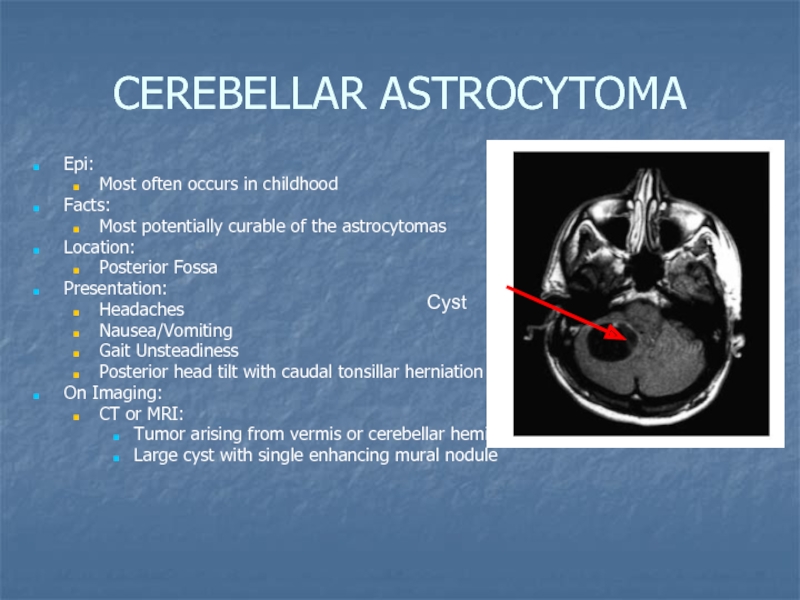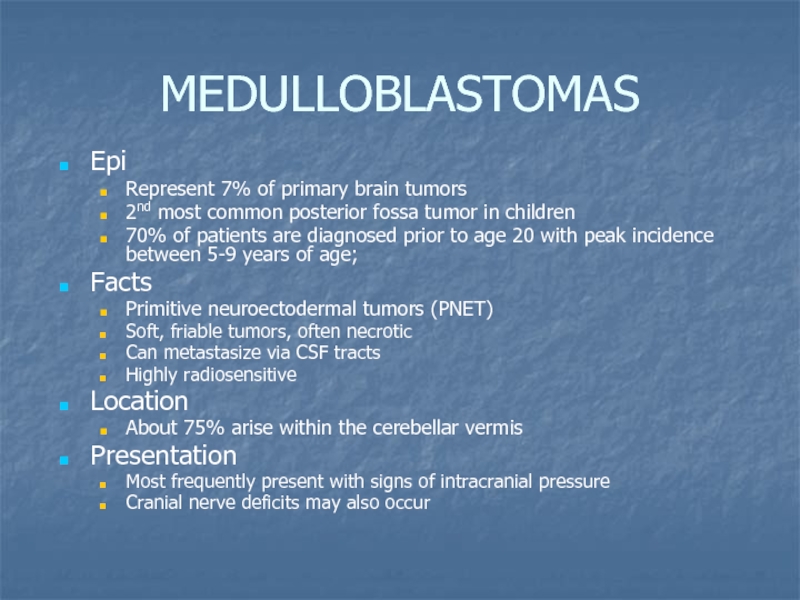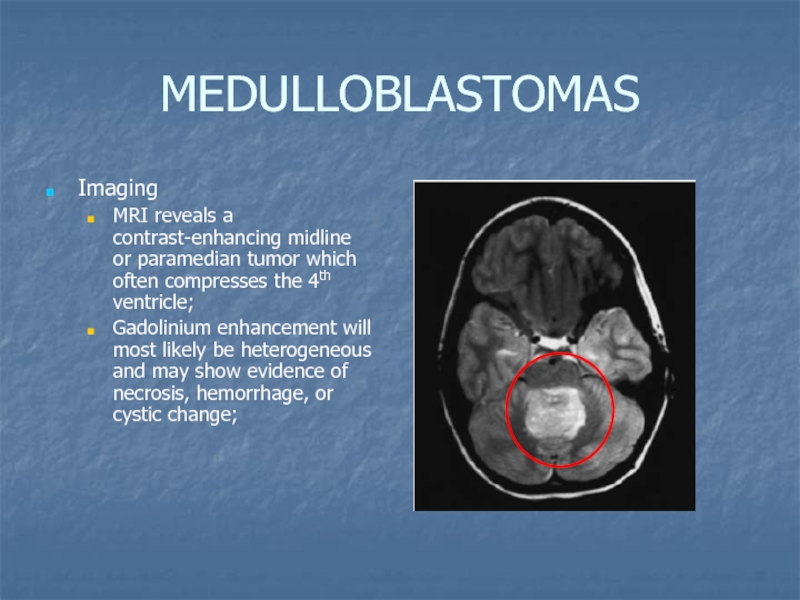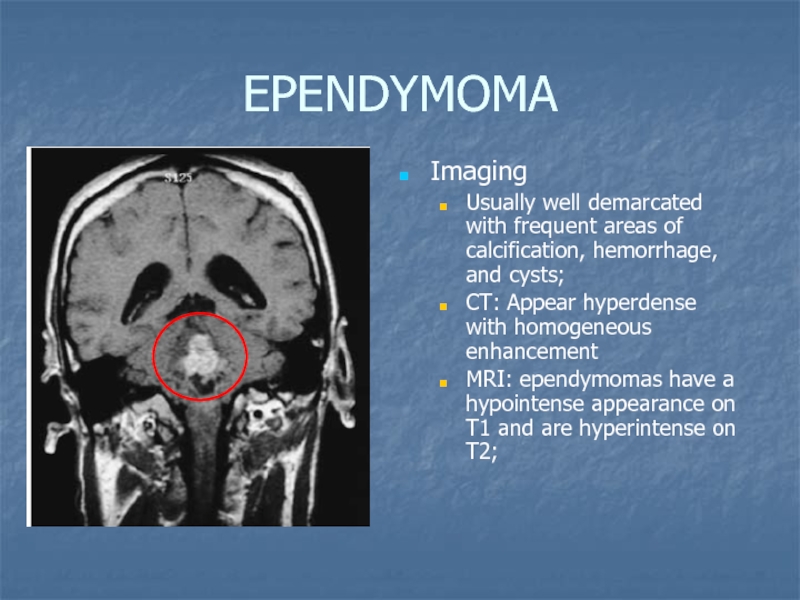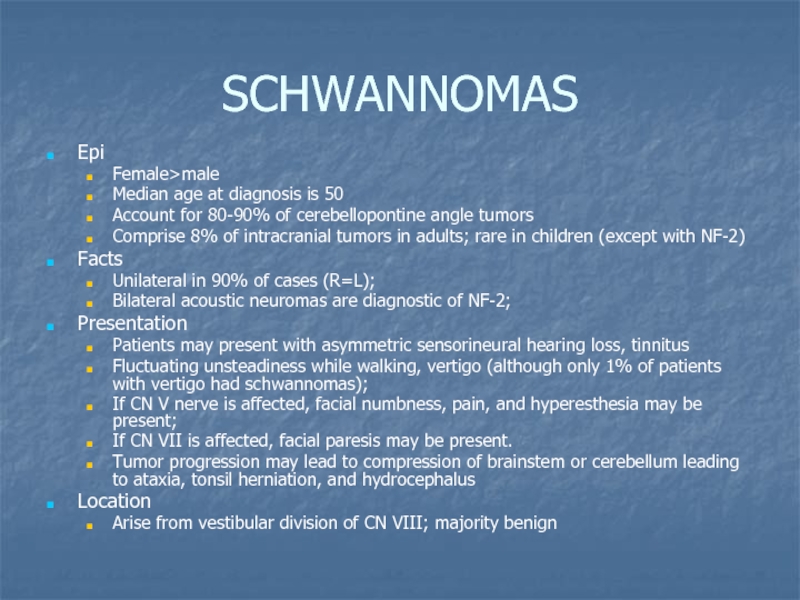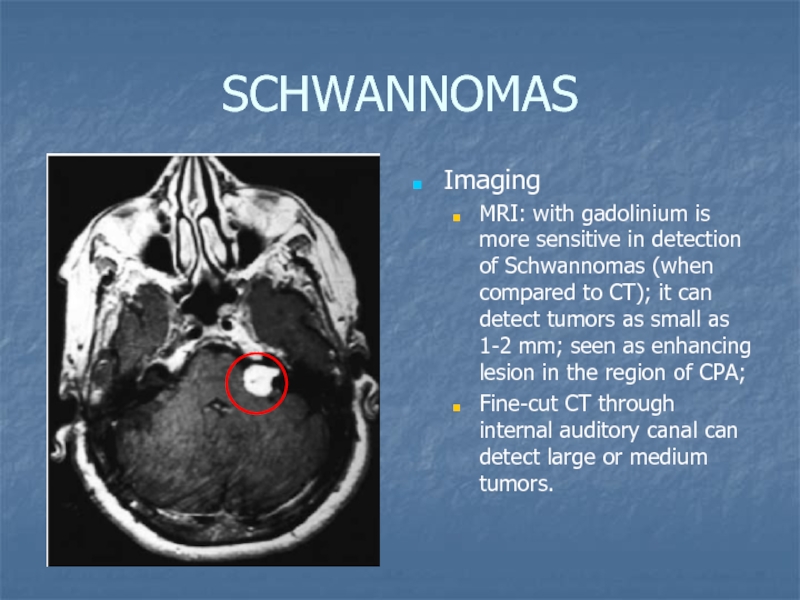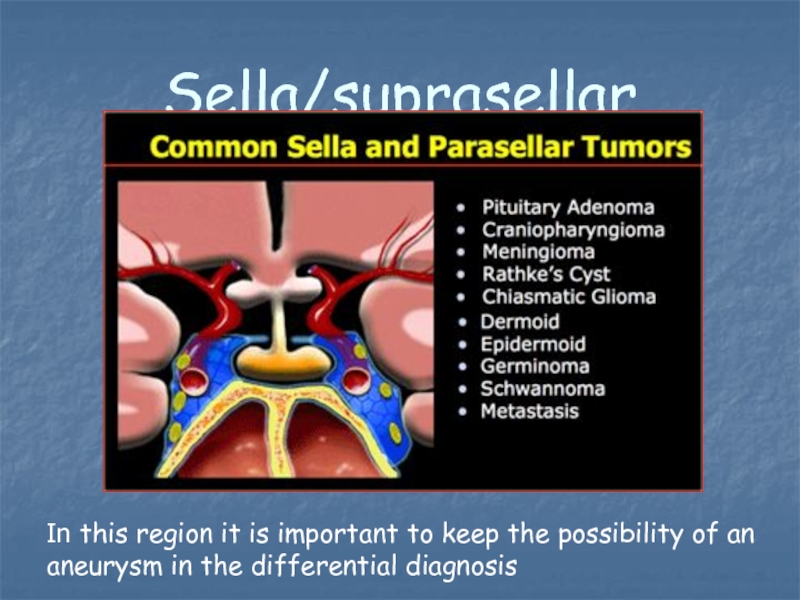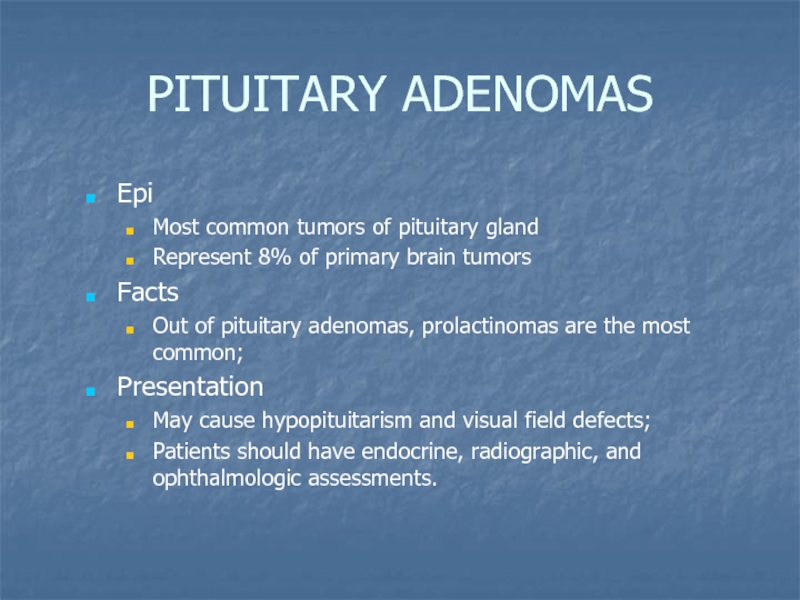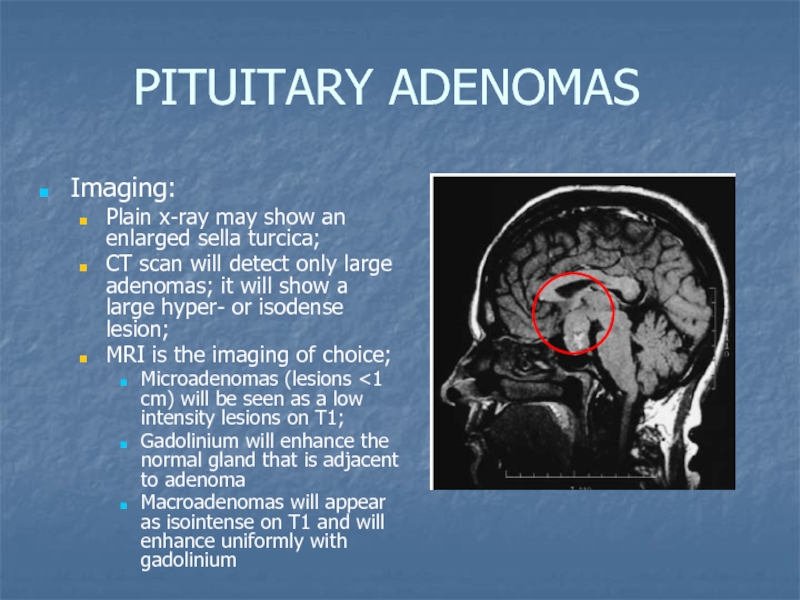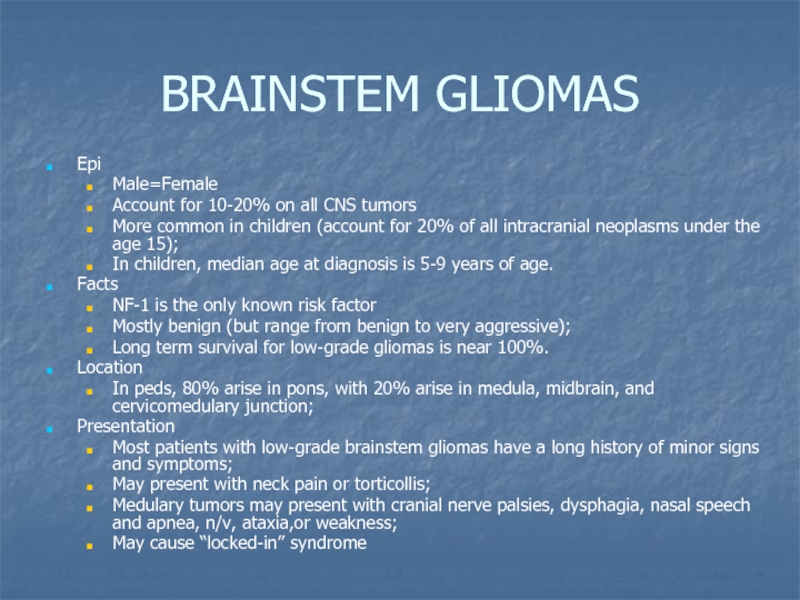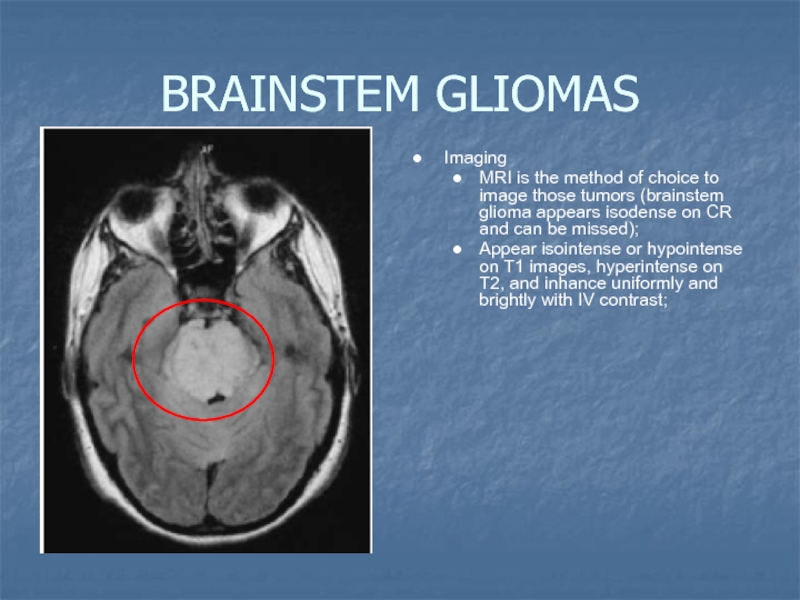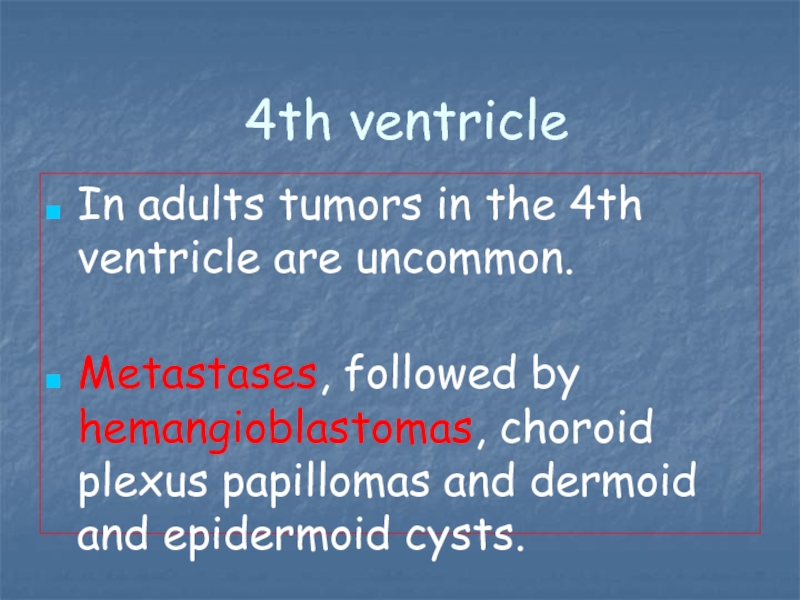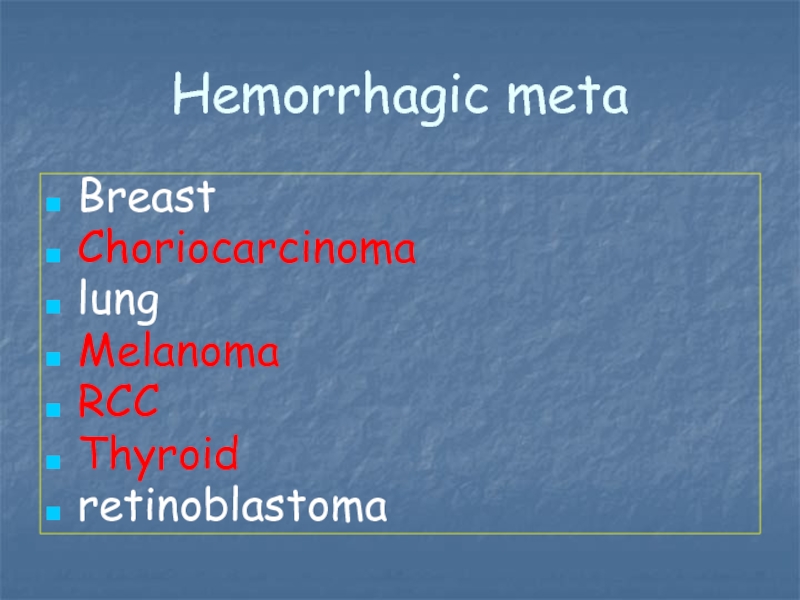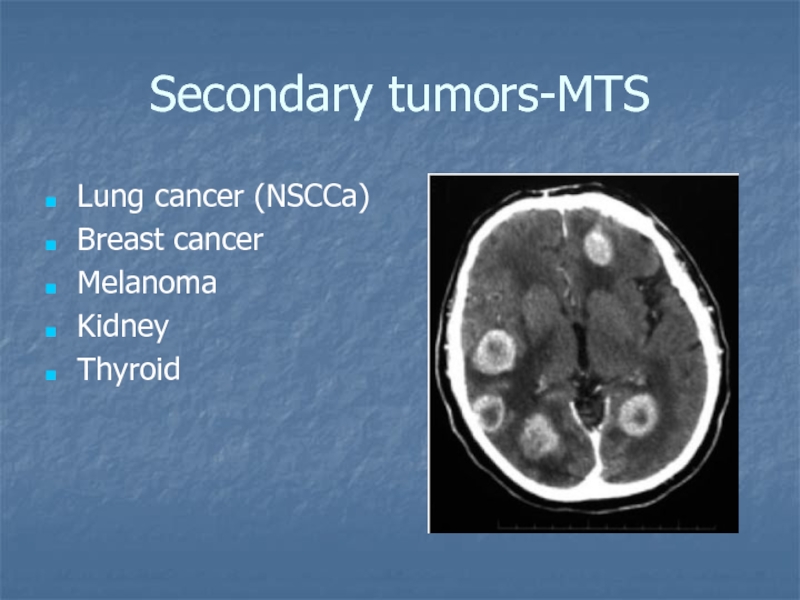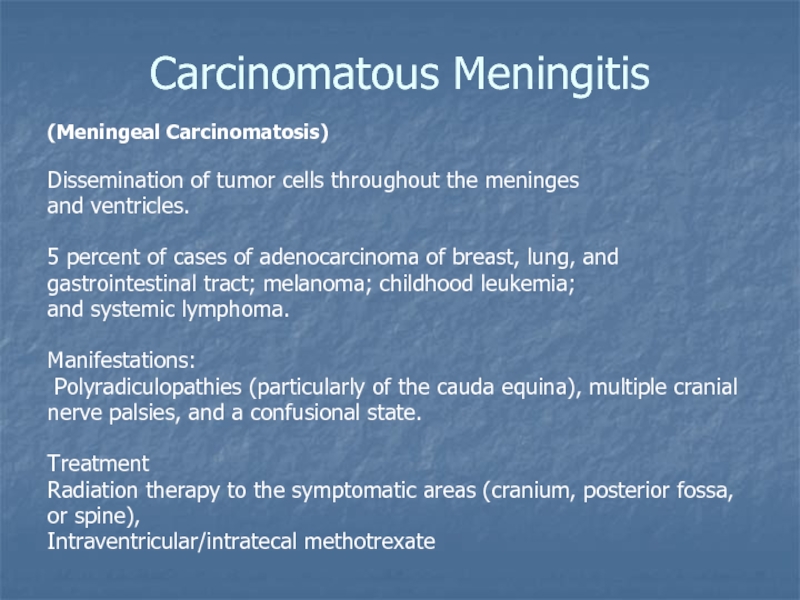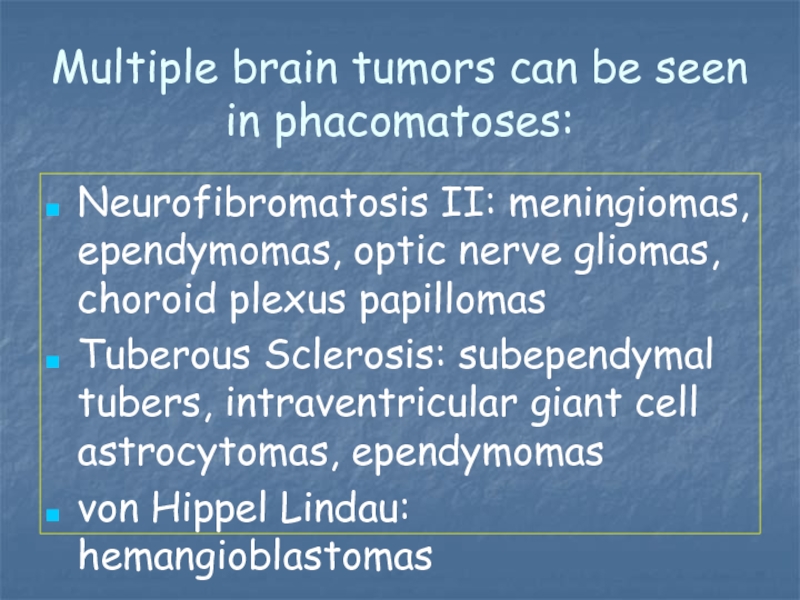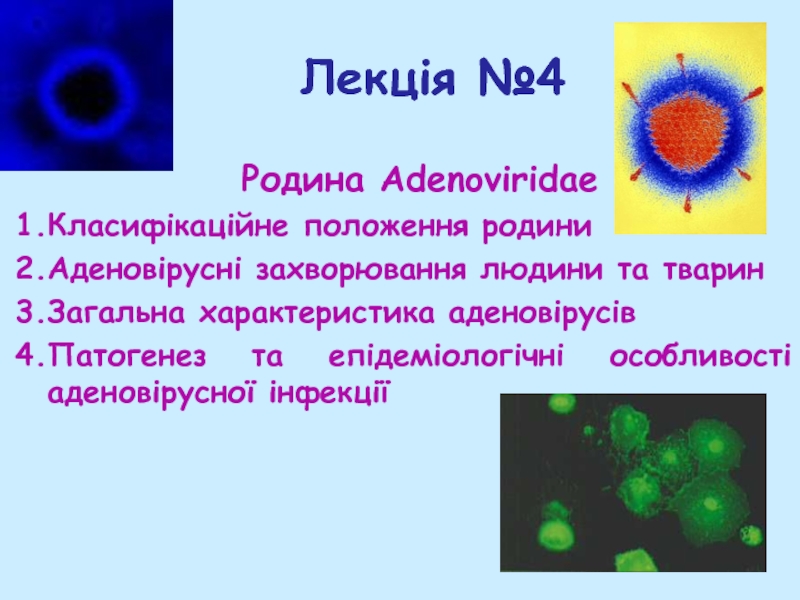- Главная
- Разное
- Дизайн
- Бизнес и предпринимательство
- Аналитика
- Образование
- Развлечения
- Красота и здоровье
- Финансы
- Государство
- Путешествия
- Спорт
- Недвижимость
- Армия
- Графика
- Культурология
- Еда и кулинария
- Лингвистика
- Английский язык
- Астрономия
- Алгебра
- Биология
- География
- Детские презентации
- Информатика
- История
- Литература
- Маркетинг
- Математика
- Медицина
- Менеджмент
- Музыка
- МХК
- Немецкий язык
- ОБЖ
- Обществознание
- Окружающий мир
- Педагогика
- Русский язык
- Технология
- Физика
- Философия
- Химия
- Шаблоны, картинки для презентаций
- Экология
- Экономика
- Юриспруденция
Neuro-oncology презентация
Содержание
- 1. Neuro-oncology
- 2. Primary tumor brain
- 3. Imaging for Brain Tumors Skull X-rays:
- 4. MRI brain T1 vs T2
- 5. Epidemiology
- 8. Infratentorial vs Supratentorial Tumors
- 9. infratentorial
- 10. MENINGIOMA1,2,3 Epi: 2nd most common primary
- 11. MENINGIOMA On Imaging CT: isodense or
- 12. GLIOMAS Arise from Glial Cells Astrocytomas
- 13. Diffuse Low Grade Astrocytoma Epi: 15%
- 14. High Grade glioma: Glioblastoma Epi: The
- 15. High Grade glioma: Glioblastoma On Imaging: Variable
- 16. High Grade glioma: Glioblastoma Treatment: steroids
- 17. Survival
- 18. OLIGODENDROGLIOMA Epi: 5-10% of primary brain
- 19. OLIGODENDROGLIOMA On Imaging: CT: Well
- 20. OLIGODENDROGLIOMA Treatment:
- 21. INFRATENTORIAL TUMORS Choroid plexus papillomas Cerebellar astrocytomas
- 22. CEREBELLAR ASTROCYTOMA Epi: Most often occurs
- 23. MEDULLOBLASTOMAS Epi Represent 7% of primary brain
- 24. MEDULLOBLASTOMAS Imaging MRI reveals a contrast-enhancing midline
- 25. EPENDYMOMAS Epi Accounts for 10% of CNS
- 26. EPENDYMOMA Imaging Usually well demarcated with frequent
- 27. SCHWANNOMAS Epi Female>male Median age at diagnosis
- 28. SCHWANNOMAS Imaging MRI: with gadolinium is more
- 29. Sella/suprasellar In this region it is important
- 30. PITUITARY ADENOMAS Epi Most common tumors of
- 31. PITUITARY ADENOMAS Imaging: Plain x-ray
- 32. BRAINSTEM GLIOMAS Epi Male=Female Account for 10-20%
- 33. BRAINSTEM GLIOMAS Imaging MRI is the
- 34. 4th ventricle In adults tumors
- 35. Metastatic tumors Parenchymal meta – most common
- 36. Hemorrhagic meta Breast Choriocarcinoma lung Melanoma RCC Thyroid retinoblastoma
- 37. Secondary tumors-MTS Lung cancer (NSCCa) Breast cancer Melanoma Kidney Thyroid
- 38. Carcinomatous Meningitis (Meningeal Carcinomatosis) Dissemination of
- 39. Multiple brain tumors can be seen in
Слайд 3Imaging for Brain Tumors
Skull X-rays:
Rarely necessary.
Useful in demonstrating calcification,
CT: Most widely used for diagnosis of brain tumors
Will detect >90% of tumors, but might miss:
Small Tumors (<0.5 cm)
Tumors Adjacent to bone (pituitary adenomas, clival tumors, and vestibular schwannomas)
Brain Stem Tumors
Low Grade Astrocytomas
More sensitive than MRI for detecting acute hemorrhage, calcification, and bony involvement
MRI: Nowadays the “golden standard” for diagnosis and follow-up of most brain tumors
More sensitive than CT scans
Can detect small tumors
Provides much greater anatomic detail
Especially useful for visualizing skull base, brain stem, & posterior fossa tumors
Слайд 10MENINGIOMA1,2,3
Epi:
2nd most common primary brain tumor after gliomas, incidence of
Usual age 40-70
F>M
Facts:
Arise from arachnoidal cap cell type from the arachnoid membrane
Usually non-invasive
Associated with NF-2
Location:
Parasagittal region
Sphenoid wing
Parasellar region
Presentation:
Asymptomatic
Symptomatic: focal or generalized seizure or gradually worsening neurologic deficit
Слайд 11MENINGIOMA
On Imaging
CT:
isodense or hypodense,
homogenous extra-axial mass with smooth or
Frequently have areas of calcification and produce hyperostosis of adjacent bone.
MRI
Isointense with gray matter on T1 images
Enhance with contrast – often with enhancing dural trail extending from the tumor attachment
Слайд 12GLIOMAS
Arise from Glial Cells
Astrocytomas
Astocytomas fall on a gradient that ranges
Oligodendrogliomas
Low Grade Pilocytic Astocytomas
Glioblastoma multiforme
Benign
Malignant
Diffuse Low Grade Astrocytomas
Слайд 13Diffuse Low Grade Astrocytoma
Epi:
15% of Astrocytomas
Young Adults
Facts:
Widely Infiltrate surrounding
Location:
Frontal Region
Subcortical white matter
Presentation:
Seizures
Headache
Slowly progressive neurologic deficits
On Imaging:
CT: Well circumscribed, non enhancing, hypodense or isodense lesion
MRI: MRI more sensitive than CT – useful for identification and establishing extent
T1 image shows abnormal areas of decreased signal
T2 image shows abnormal areas of increased signal
Usually no enhancement
Cyst
T1 weighted
T2 weighted
Слайд 14High Grade glioma: Glioblastoma
Epi:
The 2-nd place of primary brain tumor
Age of presentation: 40-60, M>F
Facts:
May arise de novo or evolve from a low-grade glioma
Tumor infiltrates along white matter tract and can cross corpus callosum
Poor Prognosis
Can look like a butterfly lesion
Location:
Frontal & Temporal Lobes
Basal Ganglia
Presentation:
Seizures,
Headache
Slowly progressive neurologic deficits
Слайд 15High Grade glioma: Glioblastoma
On Imaging: Variable
CT:
Hypodense or Isodense
Central hypodense
Surrounding edema
MRI:
T1 image shows low signal intensity
T2 image shows high signal intensity
Слайд 16High Grade glioma: Glioblastoma
Treatment: steroids
radiotherapy
chemotherapy (temozolomide)
anticonvulsive drugs
Слайд 18OLIGODENDROGLIOMA
Epi:
5-10% of primary brain tumors
Mean age of onset 40 years
Facts:
Distinguished pathologically from astrocytomas by the characteristic “fried egg” appearance.
Arises from Myelin
Location:
Superficially in Frontal Lobes
Presentation:
Seizures most common
Headache
Slowly progressive neurologic deficits
Слайд 19OLIGODENDROGLIOMA
On Imaging:
CT:
Well circumscribed, hypodense lesions with heavy calcification
Cystic degeneration
MRI:
Hypointense or isointense on T1-weighted images
Hyperintense on T2-weighted images with variable enhancement
Слайд 20OLIGODENDROGLIOMA
Treatment:
Surgical excision
anticonvulsive drugs
The median survival over 7 years.
Слайд 21INFRATENTORIAL TUMORS
Choroid plexus papillomas
Cerebellar astrocytomas
Medulloblastomas
Hemangioblastomas
Ependymomas
Brainstem gliomas
Schwannomas
Pituitary adenomas
Craniopharyngiomas
Слайд 22CEREBELLAR ASTROCYTOMA
Epi:
Most often occurs in childhood
Facts:
Most potentially curable of
Location:
Posterior Fossa
Presentation:
Headaches
Nausea/Vomiting
Gait Unsteadiness
Posterior head tilt with caudal tonsillar herniation
On Imaging:
CT or MRI:
Tumor arising from vermis or cerebellar hemispheres
Large cyst with single enhancing mural nodule
Cyst
Слайд 23MEDULLOBLASTOMAS
Epi
Represent 7% of primary brain tumors
2nd most common posterior fossa tumor
70% of patients are diagnosed prior to age 20 with peak incidence between 5-9 years of age;
Facts
Primitive neuroectodermal tumors (PNET)
Soft, friable tumors, often necrotic
Can metastasize via CSF tracts
Highly radiosensitive
Location
About 75% arise within the cerebellar vermis
Presentation
Most frequently present with signs of intracranial pressure
Cranial nerve deficits may also occur
Слайд 24MEDULLOBLASTOMAS
Imaging
MRI reveals a contrast-enhancing midline or paramedian tumor which often compresses
Gadolinium enhancement will most likely be heterogeneous and may show evidence of necrosis, hemorrhage, or cystic change;
Слайд 25EPENDYMOMAS
Epi
Accounts for 10% of CNS lesions;
Male=Female
Median age at diagnosis is
Facts
Derived from primitive glia
Overall survival at 10 years is 45-55%
Presentation
Most patients present with symptoms of increased intracranial pressure
Location
Typically arise within or adjacent to the ependymal lining of the ventricular system.
In children, 90% are intracranial with 60% arising in posterior fossa (4th ventricle is the most common infratentorial site)
Most common spinal cord glioma (in adults, 75% arise within spinal cord);;
Слайд 26EPENDYMOMA
Imaging
Usually well demarcated with frequent areas of calcification, hemorrhage, and cysts;
CT:
MRI: ependymomas have a hypointense appearance on T1 and are hyperintense on T2;
Слайд 27SCHWANNOMAS
Epi
Female>male
Median age at diagnosis is 50
Account for 80-90% of cerebellopontine angle
Comprise 8% of intracranial tumors in adults; rare in children (except with NF-2)
Facts
Unilateral in 90% of cases (R=L);
Bilateral acoustic neuromas are diagnostic of NF-2;
Presentation
Patients may present with asymmetric sensorineural hearing loss, tinnitus
Fluctuating unsteadiness while walking, vertigo (although only 1% of patients with vertigo had schwannomas);
If CN V nerve is affected, facial numbness, pain, and hyperesthesia may be present;
If CN VII is affected, facial paresis may be present.
Tumor progression may lead to compression of brainstem or cerebellum leading to ataxia, tonsil herniation, and hydrocephalus
Location
Arise from vestibular division of CN VIII; majority benign
Слайд 28SCHWANNOMAS
Imaging
MRI: with gadolinium is more sensitive in detection of Schwannomas (when
Fine-cut CT through internal auditory canal can detect large or medium tumors.
Слайд 29Sella/suprasellar
In this region it is important to keep the possibility of
Слайд 30PITUITARY ADENOMAS
Epi
Most common tumors of pituitary gland
Represent 8% of primary brain
Facts
Out of pituitary adenomas, prolactinomas are the most common;
Presentation
May cause hypopituitarism and visual field defects;
Patients should have endocrine, radiographic, and ophthalmologic assessments.
Слайд 31 PITUITARY ADENOMAS
Imaging:
Plain x-ray may show an enlarged sella turcica;
CT
MRI is the imaging of choice;
Microadenomas (lesions <1 cm) will be seen as a low intensity lesions on T1;
Gadolinium will enhance the normal gland that is adjacent to adenoma
Macroadenomas will appear as isointense on T1 and will enhance uniformly with gadolinium
Слайд 32BRAINSTEM GLIOMAS
Epi
Male=Female
Account for 10-20% on all CNS tumors
More common in children
In children, median age at diagnosis is 5-9 years of age.
Facts
NF-1 is the only known risk factor
Mostly benign (but range from benign to very aggressive);
Long term survival for low-grade gliomas is near 100%.
Location
In peds, 80% arise in pons, with 20% arise in medula, midbrain, and cervicomedulary junction;
Presentation
Most patients with low-grade brainstem gliomas have a long history of minor signs and symptoms;
May present with neck pain or torticollis;
Medulary tumors may present with cranial nerve palsies, dysphagia, nasal speech and apnea, n/v, ataxia,or weakness;
May cause “locked-in” syndrome
Слайд 33BRAINSTEM GLIOMAS
Imaging
MRI is the method of choice to image those tumors
Appear isointense or hypointense on T1 images, hyperintense on T2, and inhance uniformly and brightly with IV contrast;
Слайд 34
4th ventricle
In adults tumors in the 4th ventricle are uncommon.
Metastases,
Слайд 35Metastatic tumors
Parenchymal meta – most common masses in the in supratentorial
50% solitary, 50% multiple, 20% 2 lesions
Origin – lung, (50%), breast (15%) melanoma(11%), kidney, GIT
Cystic meta- ovary, breast, GIT
Слайд 38Carcinomatous Meningitis
(Meningeal Carcinomatosis)
Dissemination of tumor cells throughout the meninges
and ventricles.
5 percent
gastrointestinal tract; melanoma; childhood leukemia;
and systemic lymphoma.
Manifestations:
Polyradiculopathies (particularly of the cauda equina), multiple cranial
nerve palsies, and a confusional state.
Treatment
Radiation therapy to the symptomatic areas (cranium, posterior fossa,
or spine),
Intraventricular/intratecal methotrexate
Слайд 39Multiple brain tumors can be seen in phacomatoses:
Neurofibromatosis II: meningiomas,
Tuberous Sclerosis: subependymal tubers, intraventricular giant cell astrocytomas, ependymomas
von Hippel Lindau: hemangioblastomas
